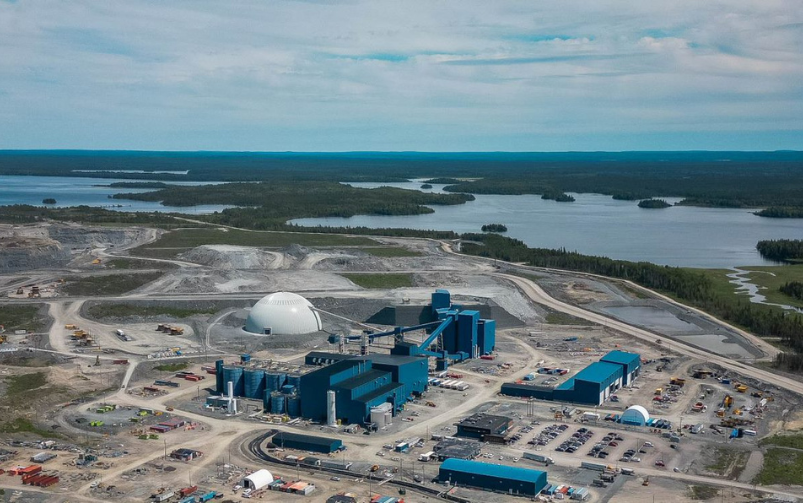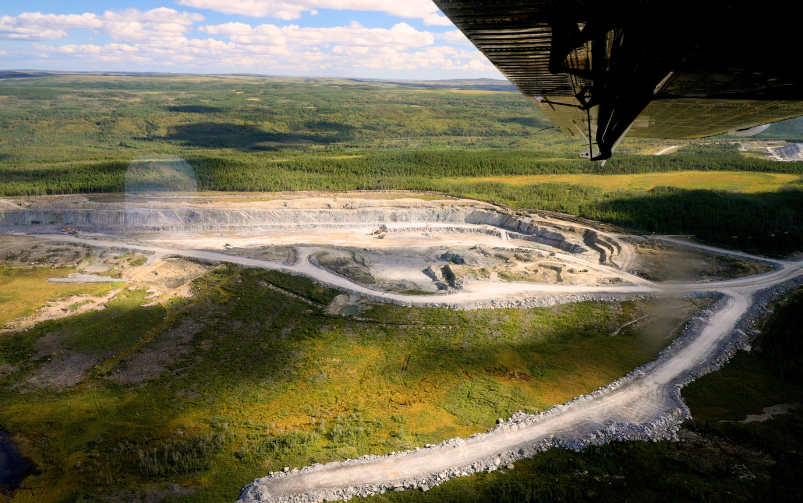NMG’s Matawinie mine is located 120 km north of Montréal, Quebec. Courtesy of NMG
Quebec-based Nouveau Monde Graphite (NMG) recently shared an update on its electrification program at its Matawinie mine, an open-pit graphite mine near the village of Saint-Michel-des-Saints, Quebec.
The company has committed to fully electrifying its equipment used for mining operations, along with ore concentration and processing activities, in Matawinie’s first five years of operation, which it said would make it the world’s first all-electric open-pit mine. To reach this goal, NMG has partnered with Caterpillar, which will be the miner’s supplier of heavy mining equipment in the transition from diesel-powered to all-electric machines.
In an Oct. 6 press release, NMG stated the two companies have finalized a partnership and established a calendar to pilot and test the equipment on-site, and to map the transition to future zero-exhaust-emission production models. The first machine the companies will pilot at the Matawinie mine is a battery-electric Cat 950 GC-wheel loader.
“These developments also support planning for the site’s charging infrastructure,” NMG stated in the release. “Modelling and simulating the location of charging stations, equipment operations on site, as well as charging cycles in relation to operational schedules and the mining plan, help optimize site design and technology choices. The simulation of charging needs helps identify peak power demand and defining energy management strategies.”
“We now have a clear plan that we both agreed to execute,” said NMG president and CEO Eric Desaulniers in an interview with CIM Magazine. “We have a lot of different equipment on our fleets, from tow trucks to wheel loaders to excavators, [and] they all have a very precise timeline to be electrified. The idea is to have [first] the diesel equivalent, receive a prototype and ensure productivity, and then switch gradually to an electrified version.”
He added that the electrification project is unique in the industry. “Caterpillar is developing the first open-pit full solution. It’s not only the equipment, but also all the charging stations, all the infrastructure around the project and the job site solution [which will be fully electrified],” Desaulniers said.
Desaulniers also believes that through its more active role at the Matawinie mining project, Caterpillar will show other miners the value of adopting sustainable equipment. “The idea was to engage Caterpillar and [other equipment manufacturers] with the transition,” Desaulniers explained. “I think the biggest progress we’ve made is to interest a large corporation like Caterpillar.”
More graphite needed
The mine is projected to produce up to 103,000 tonnes of high-grade graphite concentrate per year when it is operational and has the potential to turn into the largest graphite mine in both North America and Europe.
“We have great deposits here,” Desaulniers said. “We feel it’s our opportunity and duty to develop those projects for the North American market.”
The pressure to secure new streams of graphite production in North America and Europe is higher than ever. As of Dec. 1, 2023, China, the world’s largest producer of graphite, will limit the amount of graphite it exports by requiring foreign companies to apply for permits to receive shipments of raw and synthetic graphite.
NMG is looking to establish itself as a leader in anode material outside of China and is set to become the largest fully integrated producer of natural graphite in North America. “[It’s about] demonstrating that we're very good at making the right product and the right solution for a variety of customers,” Desaulniers said. “So, really establishing ourselves as a very trusted supplier of this anode material.”
Building social licence
As described in the Oct. 6 press release, NMG’s motivation to go all-electric at the Matawinie mine was driven by several factors: to limit its carbon footprint, commercially engage with battery/EV manufacturers and get buy-in for the development from the nearby community.
David Francis Lyon, president of engineering company Zero Nexus, which has previously worked with NMG as a consultant, said NMG’s electrification program is groundbreaking not just for its development of an all-electric open-pit mine, but also due to its emphasis on social licence.
“If you remove diesel, there’s a lot of noise that’s gone, there’s a lot of dust that’s gone, and a whole lot of pollution that’s gone from that local community,” Lyon said.
Moving to fully electric equipment can make a big impact for miners looking to reduce CO2 emissions. According to Lyon, there has been a lot of activity around electric solutions for open-pit mining in the last nine to 12 months, especially for ultra-class haul trucks, which have the potential for big dividends. “They are the biggest emitter on a mine site,” he said. “And if you look at the big[gest] mining companies, if there’s a solution for those haul trucks, then that is going to take a lot of pressure off of them for their decarbonization goals.”
From mine to market
NMG is leveraging Quebec’s hydroelectric power grid at its Matawinie mine and Bécancour battery material plant, which will take the graphite from the mine and process it into high-purity, battery-grade material. Hydro-Québec recently allocated a 77-megawatt electricity block for the battery material plant, where NMG plans to establish a fully integrated advanced manufacturing platform for refining its graphite concentrate into active anode material for batteries. “We have everything we need right there [in Bécancour], and we’re planning to produce 42,000 tonnes of finished handled material in that location,” Desaulniers said. “We are in the process of applying for all the permits for building a 14-kilometre hydroelectricity line [for the Matawinie mine] with Hydro-Québec to bring on-site… bringing electricity on site is progressing as planned.”
Earlier this year, NMG and Caterpillar also signed a non-binding memorandum of understanding to establish a full-circular value chain that would take NMG’s graphite from ore to battery materials and would power the electric fleet at Matawinie.
Next steps
Desaulniers noted that NMG is still looking to achieve key milestones, particularly around financing such a complex project. “If it were only the mine, it would be done already,” he said. “[But] it’s also the transformation of this product into a battery material where you go from a blast and a mining operation that is usually very dirty, and then you go to a surgical-grade level of cleanliness where quality is super important.”
Early construction work is under way at the mine site, and NMG has completed an eight-kilometre access road and most of the groundwork on the industrial platform. According to Desaulniers, the company has also completed all primary environmental works, including a collector basin to manage water and ensure the site is environmentally compliant. It also recently appointed Canadian construction company Pomerleau as the construction manager for the pre-construction stage of the two sites. “[Our] next big step is really to erect the building and make the foundation, [and then] focus on building the concentrator,” Desaulniers explained. “Then the [next] big milestone is raising $1 billion-plus to start the full-scale construction of both projects.”
Once project financing for the Matawinie mine is complete, Desaulniers said that the company will also accelerate work at its Uatnan mining project, which is located on Mason Graphite’s Lac Guéret graphite deposit in the Côte-Nord region of Quebec. This separate and much larger project is expected to produce approximately 500,000 tonnes of graphite concentrate annually over the course of 24 years, according to its latest preliminary economic assessment, and would be the largest natural graphite mine in the world, including China. The company also plans to conduct a feasibility study on the project in 2024.
For Lyon, NMG’s continued progress on electrification is not just a positive sign for electrification in the mining space, but also a positive for the Canadian mining industry as a whole. “Most of this electrification is, by far, taking place in Canada, and I think that puts Canadian mining in a unique position,” he said.
“We get to be leaders in [this] technology…[the] lessons learned [are] something that Canadian mining can share with the rest of the world.”




